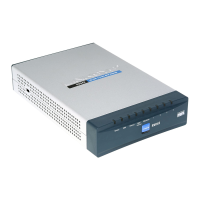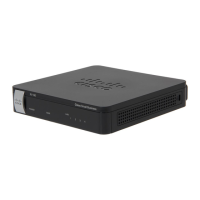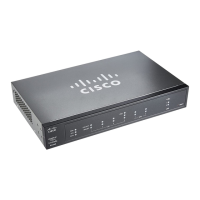Chapter 4
Advanced Configuration
17
10/100 16-Port VPN Router
Setup > UPnP
UPnP
UPnP Function Select Yes to enable the UPnP function.
Otherwise, keep the default, No.
Service Select the Service you want.
Name or IP Address Enter the name or IP address of the
server that you want the Internet users to access.
Enable Select Enable to enable this UPnP entry.
If the Service you need is not listed in the menu, click
Service Management to add the new service. The Service
Management screen appears.
Service Management
Service Name Enter a name.
Protocol Select the protocol it uses.
External Port Enter the external port number.
Internal Port Enter the internal port number.
Click Add to List. Click Save Settings to save your changes,
or click Cancel Changes to undo them. Click Exit to return
to the UPnP screen.
If you want to modify a service you have created, select it
and click Update this service. Make changes. Click Save
Settings to save your changes, or click Cancel Changes
to undo them. Click Exit to return to the UPnP screen.
If you want to delete a service you have created, select it
and click Delete selected service. Click Save Settings
to save your changes, or click Cancel Changes to undo
them. Click Exit to return to the UPnP screen.
On the UPnP screen, click Add to List, and configure as
many entries as you would like, up to a maximum of 30.
To delete an entry, select it and click Delete selected
application.
Click Show Tables to see the details of your entries. The
UPnP Forwarding Table List appears.
UPnP Forwarding Table List
Click Refresh to update the on-screen information. Click
Close to exit this screen and return to the UPnP screen.
On the UPnP screen, click Save Settings to save your
changes, or click Cancel Changes to undo them.
Setup > One-to-One NAT
One-to-One NAT (Network Address Translation) creates
a relationship that maps valid external IP addresses to
internal IP addresses hidden by NAT. A device with an
internal IP address may be accessed at the corresponding
external valid IP address.
To create this relationship, define internal and external
IP address ranges of equal length. Once the relationship
is defined, the device with the first internal IP address is
accessible at the first IP address in the external IP address
range, and so forth.
For example, you have a Local Area Network (LAN) for which
the ISP has assigned the IP address range of 209.19.28.16
to 209.19.28.31, with 209.19.28.16 used as the Wide Area
Network (WAN) or NAT public IP address of the Router.
The address range of 192.168.168.1 to 192.168.168.255 is
used for the devices on the LAN. With One-to-One NAT,
the devices with the internal IP addresses of 192.168.168.2
to 192.168.168.15 may be accessed at the corresponding
external IP addresses.
NOTE: The Router’s WAN IP address should not
be included in the range you specify.

